Experimental Study on the Potential Use of Bundled Crop Straws as Subsurface Drainage Material in the Newly Reclaimed Coastal Land in Eastern China
Abstract
:1. Introduction
- (1)
- Compare the soil moisture distributions in saline soils as affected by subsurface drainage with bundled maize stalks, rice straws and perforated plastic pipes;
- (2)
- Examine drainage effect of the bundled maize stalks and rice straws in lowering water table and discharge drainage water as compared to the perforated plastic pipes; and
- (3)
- Compare the effects of the three drainage materials on maize yield and root growth to confirm applicability of the straw drainage in early stage of land reclamation of the saline coastal soils.
2. Materials and Methods
2.1. Site Description and Experimental Setup
2.2. Sample Collection and Analysis
2.3. Evaluation Methods
2.4. Statistical Analysis
3. Results and Discussion
3.1. Variability of Soil Moisture Content
3.2. Drainage Performance
3.2.1. Variation of Water Table Depth and Drainage Rate
3.2.2. Drainage Effect
3.3. Variations of Soil Salinity
3.4. Responses of Maize Growth
4. Conclusions
- (1)
- Subsurface drainage with crop straws had positive effect on the salt and water distribution in the soil profile; less soil moisture variation and higher desalination rate were observed in the root zone drained with the bundled crop straw than that drained with the conventional plastic pipes.
- (2)
- The crop straws drainage modules displayed faster soil water transmission properties, as reflected in the quick water table drawdown, greater average drainage rate and leaching fraction.
- (3)
- The crop straw treatments produced better crop growth in terms of the root distribution, plant length, stem diameter and shoot dry weight of the maize, showing potential benefit of the organic drainage material.
Acknowledgments
Author Contributions
Conflicts of Interest
References
- Long, X.H.; Liu, L.P.; Shao, T.Y.; Shao, H.B.; Liu, Z.P. Developing and sustainably utilize the coastal mudflat areas in China. Sci. Total Environ. 2016, 569, 1077–1086. [Google Scholar] [CrossRef] [PubMed]
- Li, J.; Pu, L.; Zhu, M.; Zhang, J.; Li, P.; Dai, X.; Xu, Y.; Liu, L. Evolution of soil properties following reclamation in coastal areas: A review. Geoderma 2014, 226, 130–139. [Google Scholar] [CrossRef]
- Bu, N.-S.; Qu, J.-F.; Li, G.; Zhao, B.; Zhang, R.-J.; Fang, C.-M. Reclamation of coastal salt marshes promoted carbon loss from previously-sequestered soil carbon pool. Ecol. Eng. 2015, 81, 335–339. [Google Scholar] [CrossRef]
- Fernandez, S.; Santin, C.; Marquinez, J.; Alvarez, M.A. Saltmarsh soil evolution after land reclamation in atlantic estuaries (Bay of Biscay, North Coast of Spain). Geomorphology 2010, 114, 497–507. [Google Scholar] [CrossRef]
- Qureshi, A.S.; McCornick, P.G.; Qadir, M.; Aslam, Z. Managing salinity and waterlogging in the Indus Basin of Pakistan. Agric. Water Manag. 2008, 95, 1–10. [Google Scholar] [CrossRef]
- Youngs, E.G.; Leeds-Harrison, P.B. Improving efficiency of desalinization with subsurface drainage. J. Irrig. Drain. Eng. ASCE 2000, 126, 375–380. [Google Scholar] [CrossRef]
- Christen, E.W.; Ayars, J.E.; Hornbuckle, J.W. Subsurface drainage design and management in irrigated areas of Australia. Irrig. Sci. 2001, 21, 35–43. [Google Scholar] [CrossRef]
- Mehnert, E.; Hwang, H.-H.; Johnson, T.M.; Sanford, R.A.; Beaumont, W.C.; Holm, T.R. Denitrification in the shallow ground water of a tile-drained, agricultural watershed. J. Environ. Qual. 2007, 36, 80–90. [Google Scholar] [CrossRef] [PubMed]
- Lenhart, C.; Gordon, B.; Gamble, J.; Current, D.; Ross, N.; Herring, L.; Nieber, J.; Peterson, H. Design and hydrologic performance of a tile drainage treatment wetland in Minnesota, USA. Water 2016, 8, 549. [Google Scholar] [CrossRef]
- Gong, D.Y.; Ho, C.H. Shift in the summer rainfall over the Yangtze River valley in the late 1970s. Geophys. Res. Lett. 2002, 29, 10. [Google Scholar] [CrossRef]
- Shao, X.-H.; Chang, T.-T.; Cai, F.; Wang, Z.-Y.; Huang, M.-Y. Effects of subsurface drainage design on soil desalination in coastal resort of China. J. Food Agric. Environ. 2012, 10, 935–938. [Google Scholar]
- Afruzi, A.; Nazemi, A.H.; Sadraddini, A.A. Steady-state subsurface drainage of ponded fields by rectangular ditch drains. Irrig. Drain. 2014, 63, 668–681. [Google Scholar] [CrossRef]
- Manjunatha, M.V.; Oosterbaan, R.J.; Gupta, S.K.; Rajkumar, H.; Jansen, H. Performance of subsurface drains for reclaiming waterlogged saline lands under rolling topography in Tungabhadra irrigation project in India. Agric. Water Manag. 2004, 69, 69–82. [Google Scholar] [CrossRef]
- Sharma, D.R.; Gupta, S.K. Subsurface drainage for reversing degradation of waterlogged saline lands. Land Degrad. Dev. 2006, 17, 605–614. [Google Scholar] [CrossRef]
- Skaggs, R.W.; Breve, M.A.; Gilliam, J.W. Hydrologic and water quality impacts of agricultural drainage. Crit. Rev. Environ. Sci. Technol. 1994, 24, 1–32. [Google Scholar] [CrossRef]
- Yu, S.; Liu, J.; Eneji, A.E.; Han, L.; Tan, L.; Liu, H. Dynamics of soil water and salinity under subsurface drainage of a coastal area with high groundwater table in spring and rainy season. Irrig. Drain. 2016, 65, 360–370. [Google Scholar] [CrossRef]
- Rozemeijer, J.C.; Visser, A.; Borren, W.; Winegram, M.; van der Velde, Y.; Klein, J.; Broers, H.P. High-frequency monitoring of water fluxes and nutrient loads to assess the effects of controlled drainage on water storage and nutrient transport. Hydrol. Earth Syst. Sci. 2016, 20, 347–358. [Google Scholar] [CrossRef]
- Jain, N.; Bhatia, A.; Pathak, H. Emission of air pollutants from crop residue burning in India. Aerosol Air Qual. Res. 2014, 14, 422–430. [Google Scholar] [CrossRef]
- Yaman, B.; Aydin, Y.M.; Koca, H.; Dasdemir, O.; Kara, M.; Altiok, H.; Dumanoglu, Y.; Bayram, A.; Tolunay, D.; Odabasi, M.; et al. Biogenic volatile organic compound (BVOC) emissions from various endemic tree species in Turkey. Aerosol Air Qual. Res. 2015, 15, 341–356. [Google Scholar] [CrossRef]
- Gadde, B.; Bonnet, S.; Menke, C.; Garivait, S. Air pollutant emissions from rice straw open field burning in India, Thailand and the Philippines. Environ. Pollut. 2009, 157, 1554–1558. [Google Scholar] [CrossRef] [PubMed]
- Shi, T.; Liu, Y.; Zhang, L.; Hao, L.; Gao, Z. Burning in agricultural landscapes: An emerging natural and human issue in China. Landsc. Ecol. 2014, 29, 1785–1798. [Google Scholar] [CrossRef]
- Tian, H.; Zhao, D.; Wang, Y. Emission inventories of atmospheric pollutants discharged from biomass burning in China. Acta Sci. Circumst. 2011, 31, 349–357. [Google Scholar]
- Dahiya, R.; Ingwersen, J.; Streck, T. The effect of mulching and tillage on the water and temperature regimes of a loess soil: Experimental findings and modeling. Soil Tillage Res. 2007, 96, 52–63. [Google Scholar] [CrossRef]
- Ramakrishna, A.; Tam, H.M.; Wani, S.P.; Long, T.D. Effect of mulch on soil temperature, moisture, weed infestation and yield of groundnut in northern Vietnam. Field Crop. Res. 2006, 95, 115–125. [Google Scholar] [CrossRef]
- Huang, Y.L.; Chen, L.D.; Fu, B.J.; Huang, Z.L.; Gong, E. The wheat yields and water-use efficiency in the loess plateau: Straw mulch and irrigation effects. Agric. Water Manag. 2005, 72, 209–222. [Google Scholar] [CrossRef]
- Bi, L.; Zhang, B.; Liu, G.; Li, Z.; Liu, Y.; Ye, C.; Yu, X.; Lai, T.; Zhang, J.; Yin, J.; et al. Long-term effects of organic amendments on the rice yields for double rice cropping systems in subtropical China. Agric. Ecosyst. Environ. 2009, 129, 534–541. [Google Scholar] [CrossRef]
- Zhao, Y.; Pang, H.; Wang, J.; Li, Y.; Li, Y. Depth of stover layer for salt management influences sunflower production in saline soils. Crop Sci. 2016, 56, 1948–1961. [Google Scholar] [CrossRef]
- Dias, D.; Lapa, N.; Bernardo, M.; Godinho, D.; Fonseca, I.; Miranda, M.; Pinto, F.; Lemos, F. Properties of chars from the gasification and pyrolysis of rice waste streams towards their valorisation as adsorbent materials. Waste Manag. 2017, 65, 186–194. [Google Scholar] [CrossRef] [PubMed]
- Mitchell, R.D.J.; Harrison, R.; Russell, K.J.; Webb, J. The effect of crop residue incorporation date on soil inorganic nitrogen, nitrate leaching and nitrogen mineralization. Biol. Fertil. Soils 2000, 32, 294–301. [Google Scholar] [CrossRef]
- Mohan, D.; Pittman, C.U.; Steele, P.H. Pyrolysis of wood/biomass for bio-oil: A critical review. Energy Fuels 2006, 20, 848–889. [Google Scholar] [CrossRef]
- Li, C.X.; Zhang, J.Q.; Fan, D.D.; Deng, B. Holocene regression and the tidal radial sand ridge system formation in the Jiangsu coastal zone, east China. Mar. Geol. 2001, 173, 97–120. [Google Scholar] [CrossRef]
- Sun, J.; Kang, Y.; Wan, S. Effects of an imbedded gravel-sand layer on reclamation of coastal saline soils under drip irrigation and on plant growth. Agric. Water Manag. 2013, 123, 12–19. [Google Scholar] [CrossRef]
- Kang, Y.; Chen, M.; Wan, S. Effects of drip irrigation with saline water on waxy maize (Zea mays L. Var Ceratina kulesh) in north China plain. Agric. Water Manag. 2010, 97, 1303–1309. [Google Scholar] [CrossRef]
- Lacerda, C.F.; Sousa, G.G.; Silva, F.L.B.; Guimaraes, F.V.A.; Silva, G.L.; Cavalcante, L.F. Soil salinization and maize and cowpea yield in the crop rotation system using saline waters. Eng. Agricola 2011, 31, 663–675. [Google Scholar] [CrossRef]
- Neidhardt, H.; Norra, S.; Tang, X.; Guo, H.; Stuben, D. Impact of irrigation with high arsenic burdened groundwater on the soil-plant system: Results from a case study in the Inner Mongolia, China. Environ. Pollut. 2012, 163, 8–13. [Google Scholar] [CrossRef] [PubMed]
- Wang, Q.; Huo, Z.; Zhang, L.; Wang, J.; Zhao, Y. Impact of saline water irrigation on water use efficiency and soil salt accumulation for spring maize in arid regions of China. Agric. Water Manag. 2016, 163, 125–138. [Google Scholar] [CrossRef]
- Feng, G.; Zhang, Z.; Wan, C.; Lu, P.; Bakour, A. Effects of saline water irrigation on soil salinity and yield of summer maize (Zea mays L.) in subsurface drainage system. Agric. Water Manag. 2017, 193, 205–213. [Google Scholar] [CrossRef]
- Chang, T.; Shao, X.; Ye, H.; Li, W.; Zhang, J.; Zhang, Z. Irrigation scheduling for corn in a coastal saline soil. Int. J. Agric. Biol. Eng. 2016, 9, 91–99. [Google Scholar]
- Liu, C.W.; Cheng, S.W.; Yu, W.S.; Chen, S.K. Water infiltration rate in cracked paddy soil. Geoderma 2003, 117, 169–181. [Google Scholar] [CrossRef]
- Nosetto, M.D.; Jobbagy, E.G.; Jackson, R.B.; Sznaider, G.A. Reciprocal influence of crops and shallow ground water in sandy landscapes of the inland pampas. Field Crop. Res. 2009, 113, 138–148. [Google Scholar] [CrossRef]
- Sharma, D.P.; Tyagi, N.K. On-farm management of saline drainage water in arid and semi-arid regions. Irrig. Drain. 2004, 53, 87–103. [Google Scholar] [CrossRef]
- Singh, A. Decision support for on-farm water management and long-term agricultural sustainability in a semi-arid region of India. J. Hydrol. 2010, 391, 65–78. [Google Scholar] [CrossRef]
- Rasool, R.; Kukal, S.S.; Hira, G.S. Soil organic carbon and physical properties as affected by long-term application of FYM and inorganic fertilizers in maize-wheat system. Soil Tillage Res. 2008, 101, 31–36. [Google Scholar] [CrossRef]
- Tejada, M.; Gonzalez, J.L.; Garcia-Martinez, A.M.; Parrado, J. Effects of different green manures on soil biological properties and maize yield. Bioresour. Technol. 2008, 99, 1758–1767. [Google Scholar] [CrossRef] [PubMed]
- Beltran, J.M. Irrigation with saline water: Benefits and environmental impact. Agric. Water Manag. 1999, 40, 183–194. [Google Scholar] [CrossRef]
- Fu, P.; Hu, S.; Xiang, J.; Sun, L.; Su, S.; Wang, J. Evaluation of the porous structure development of chars from pyrolysis of rice straw: Effects of pyrolysis temperature and heating rate. J. Anal. Appl. Pyrolysis 2012, 98, 177–183. [Google Scholar] [CrossRef]
- Araguees, R.; Teresa Medina, E.; Claveria, I. Effectiveness of inorganic and organic mulching for soil salinity and sodicity control in a grapevine orchard drip-irrigated with moderately saline waters. Span. J. Agric. Res. 2014, 12, 501–508. [Google Scholar] [CrossRef]
- Malash, N.M.; Flowers, T.J.; Ragab, R. Effect of irrigation methods, management and salinity of irrigation water on tomato yield, soil moisture and salinity distribution. Irrig. Sci. 2008, 26, 313–323. [Google Scholar] [CrossRef]
- Fiebig, A.; Dodd, I.C. Inhibition of tomato shoot growth by over-irrigation is linked to nitrogen deficiency and ethylene. Physiol. Plant. 2016, 156, 70–83. [Google Scholar] [CrossRef] [PubMed]
- Mathew, E.K.; Panda, R.K.; Nair, M. Influence of subsurface drainage on crop production and soil quality in a low-lying acid sulphate soil. Agric. Water Manag. 2001, 47, 191–209. [Google Scholar] [CrossRef]
- Da Rocha, M.G.; Faria, L.N.; Casaroli, D.; Van Lier, Q.D.J. Evaluation of a root-soil water extraction model by root systems divided over soil layers with distinct hydraulic properties. Rev. Bras. Cienc. Solo 2010, 34, 1017–1028. [Google Scholar]
- Haws, N.W.; Rao, P.S.C.; Simunek, J.; Poyer, I.C. Single-porosity and dual-porosity modeling of water flow and solute transport in subsurface-drained fields using effective field-scale parameters. J. Hydrol. 2005, 313, 257–273. [Google Scholar] [CrossRef]
- Wang, J.M.; Wang, P.; Qin, Q.; Wang, H.D. The effects of land subsidence and rehabilitation on soil hydraulic properties in a mining area in the loess plateau of China. Catena 2017, 159, 51–59. [Google Scholar] [CrossRef]
- Farooq, M.; Hussain, M.; Wakeel, A.; Siddique, K.H.M. Salt stress in maize: Effects, resistance mechanisms, and management. A review. Agron. Sustain. Dev. 2015, 35, 461–481. [Google Scholar] [CrossRef]
- Katerji, N.; van Hoorn, J.W.; Hamdy, A.; Mastrorilli, M. Salinity effect on crop development and yield, analysis of salt tolerance according to several classification methods. Agric. Water Manag. 2003, 62, 37–66. [Google Scholar] [CrossRef]
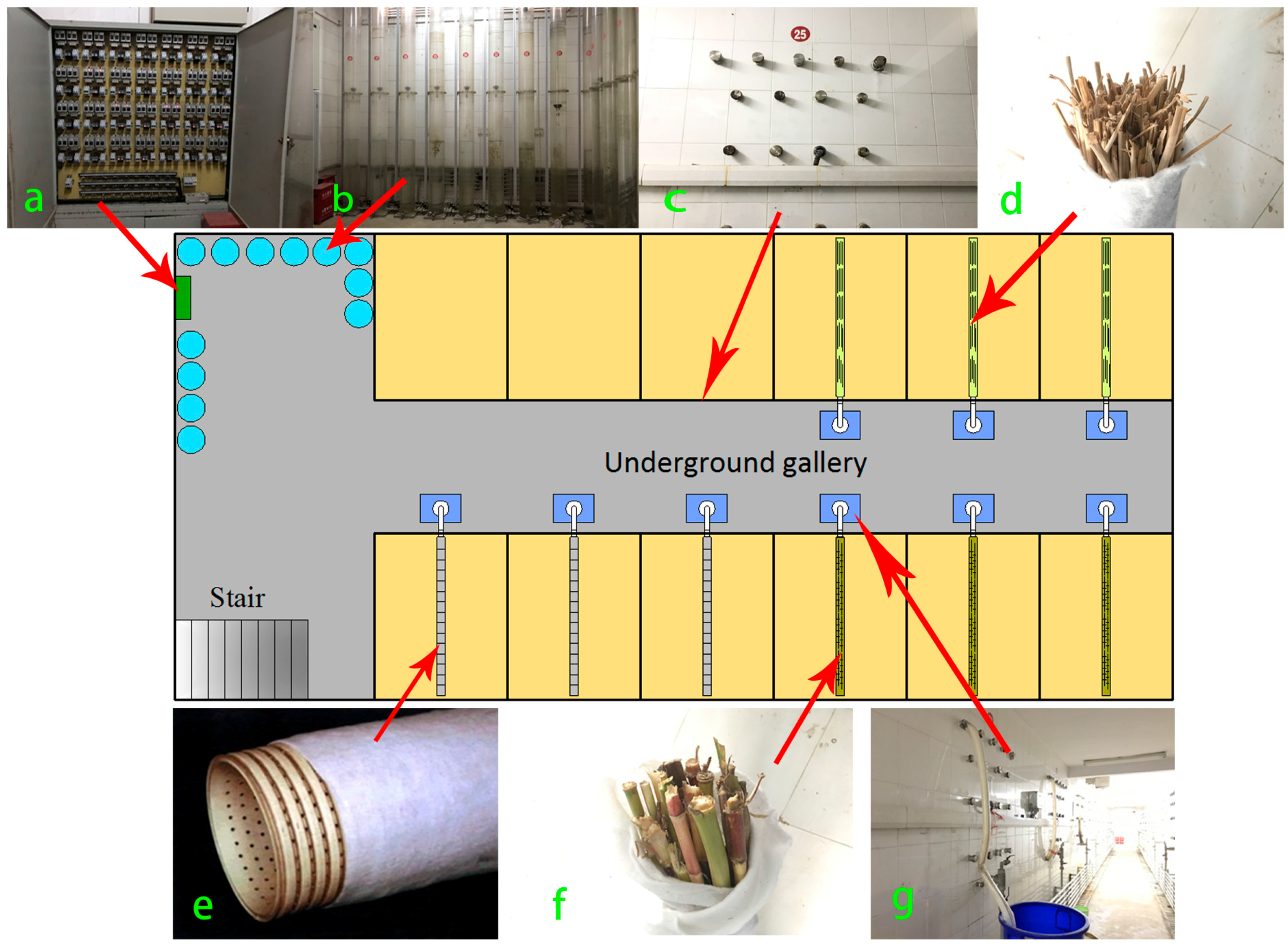
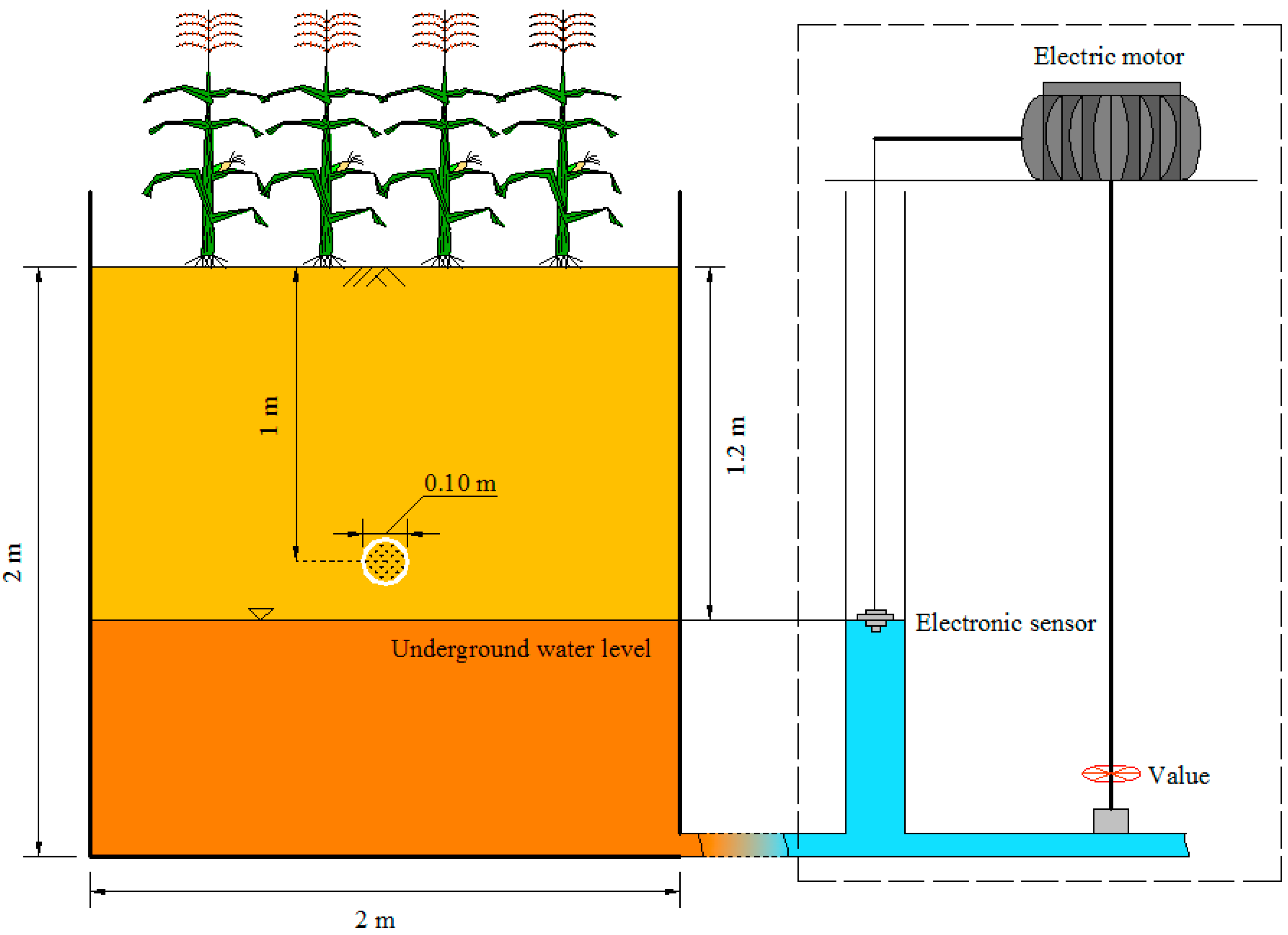
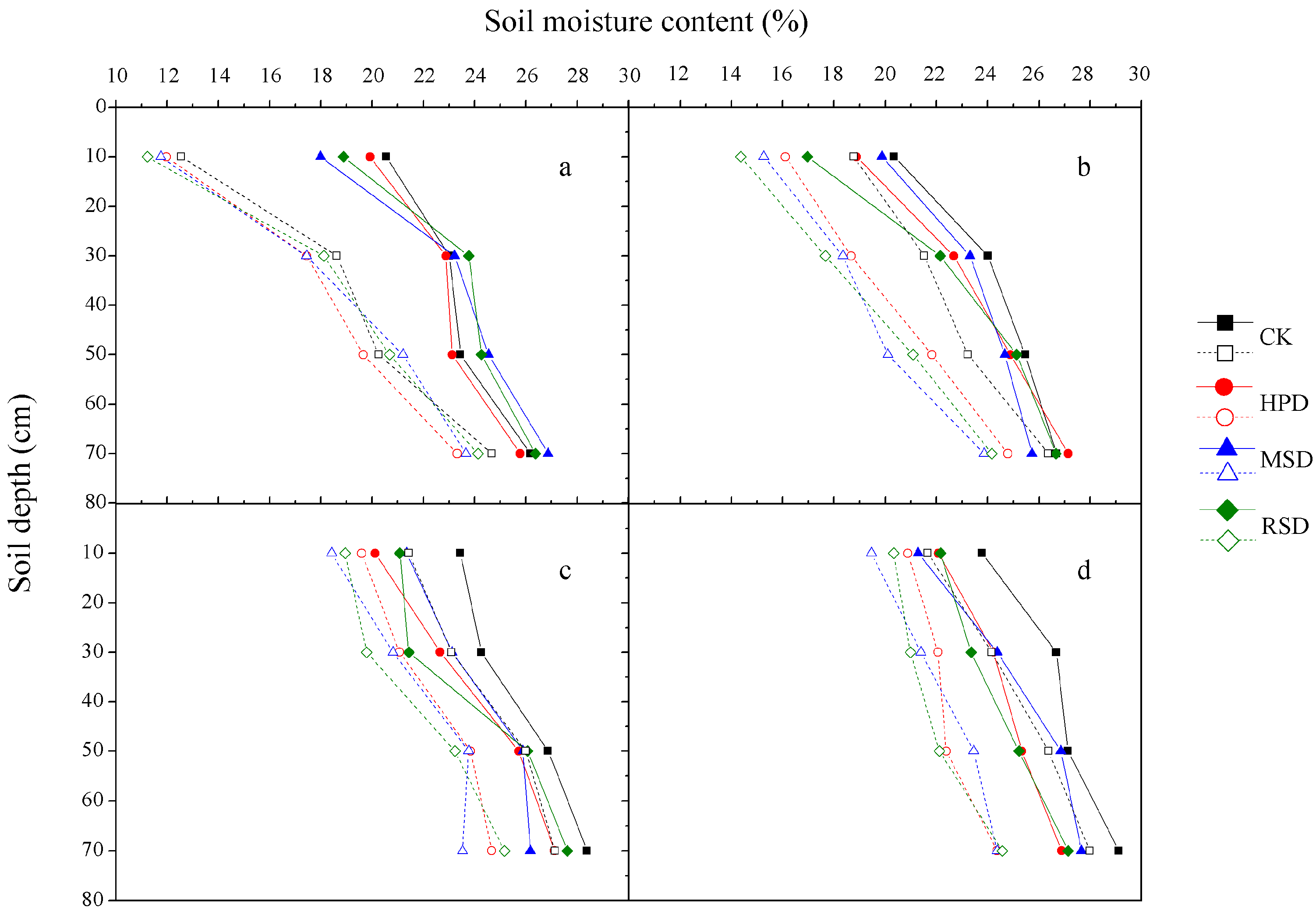
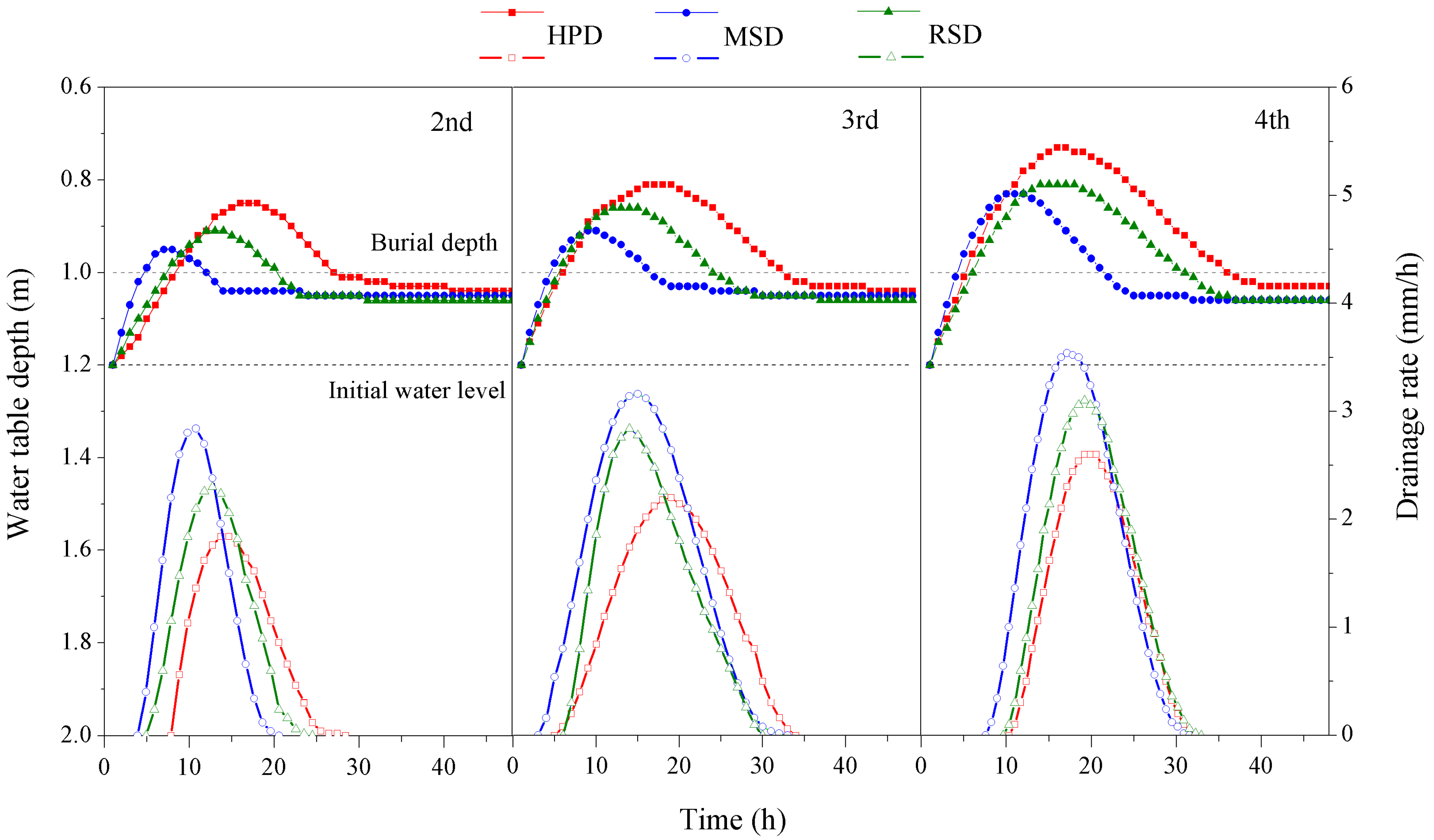

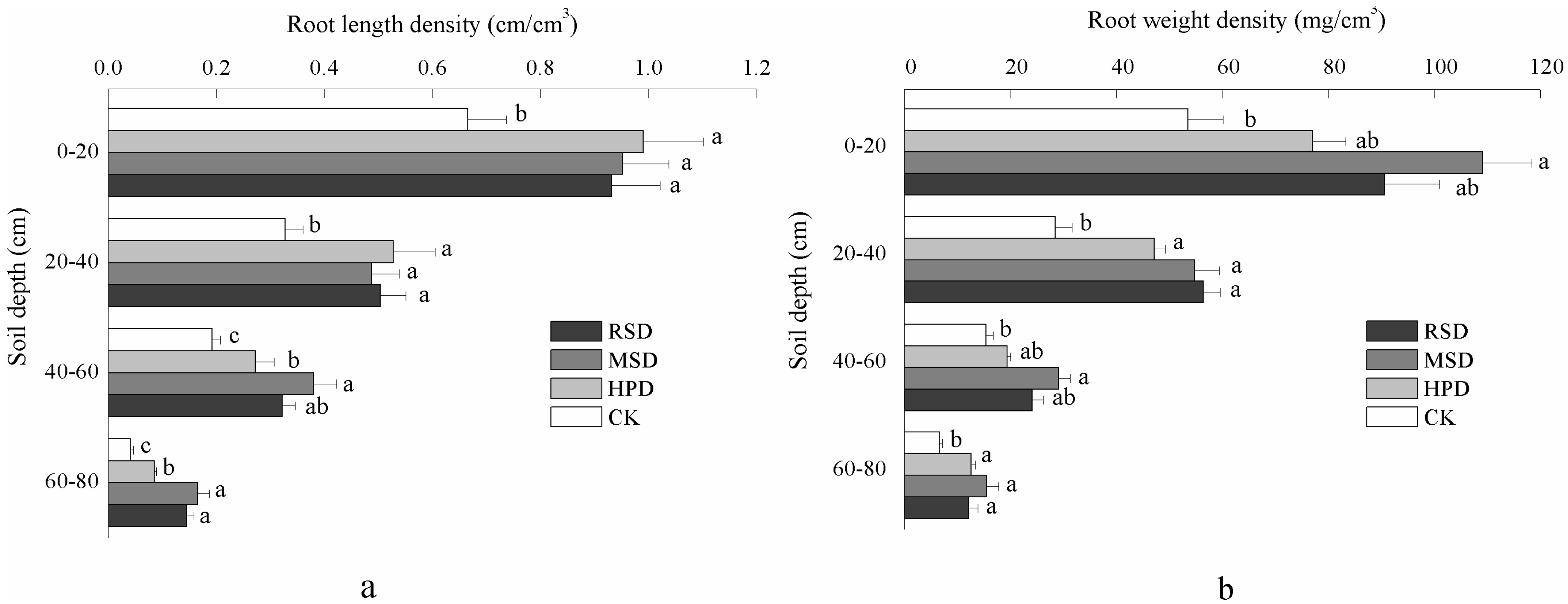
| Soil Layer (cm) | Treatments | First Evaporation Period (23 July–15 August) | Second Evaporation Period (18 August–7 September) | Third Evaporation Period (10–29 September) | Fourth Evaporation Period (2–20 October) |
|---|---|---|---|---|---|
| 0–20 cm | CK | 38.91% a | 7.76% c | 6.61% b | 7.92% b |
| HPD | 39.86% a | 14.72% b | 8.20% b | 8.55% ab | |
| MSD | 34.63% a | 23.20% a | 9.45% a | 10.33% a | |
| RED | 40.55% a | 15.32% b | 10.10% a | 9.26% a | |
| 20–40 cm | CK | 19.07% a | 10.33% b | 4.74% b | 7.11% b |
| HPD | 23.73% a | 17.64% ab | 7.65% a | 10.15% ab | |
| MSD | 24.86% a | 21.28% a | 8.12% a | 12.23% a | |
| RED | 23.77% a | 20.27% a | 8.87% a | 11.16% a | |
| 40–60 cm | CK | 13.65% a | 8.76% b | 3.28% b | 2.80% b |
| HPD | 14.97% a | 12.29% ab | 7.27% a | 9.65% a | |
| MSD | 13.65% a | 18.48% a | 8.19% a | 12.66% a | |
| RED | 14.76% a | 16.12% a | 10.89% a | 12.33% a | |
| 60–80 cm | CK | 7.60% b | 1.16% b | 4.37% b | 3.91% b |
| HPD | 9.51% ab | 8.70% a | 9.03% a | 9.34% a | |
| MSD | 11.95% a | 7.23% a | 10.09% a | 11.86% a | |
| RED | 8.49% ab | 9.38% a | 10.91% a | 9.51% a |
| Treatment | Irrigation Volume (mm) | Groundwater Supply (mm) | Subsurface Drainage (mm) | |||||||||
|---|---|---|---|---|---|---|---|---|---|---|---|---|
| 20 July | 16 August | 8 September | 30 September | 23 July–15 August | 18 August–7 September | 10–29 September | 2–20 October | 20–21 July | 16–18 August | 8–9 September | 30 September–1 October | |
| CK | 40 | 80 | 120 | 160 | 100.66 | 12.42 | 7.86 | 5.96 | 0 | 0 | 0 | 0 |
| HPD | 40 | 80 | 120 | 160 | 96.19 | 52.91 | 33.32 | 25.83 | 0 | 26.69 | 45.79 | 74.83 |
| MSD | 40 | 80 | 120 | 160 | 105.28 | 57.47 | 36.17 | 28.04 | 0 | 29.42 | 57.14 | 93.86 |
| RSD | 40 | 80 | 120 | 160 | 103.11 | 56.85 | 35.78 | 27.73 | 0 | 28.21 | 51.89 | 84.03 |
| Soil Depth (cm) | Drainage Type | Soil EC1:5 (ms/m) | Soil Desalination Rate | ||||||||
|---|---|---|---|---|---|---|---|---|---|---|---|
| Seeding Stage | Jointing Stage | Tasseling Stage | Filling Stage | Full Ripe Stage | |||||||
| 0–20 | CK | 193.23(11.23) | First irrigation (40 mm 20 July) | 204.67(15.26) | Second irrigation (80 mm 16 August) | 199.26(11.85) | Third irrigation (120 mm 8 September) | 186.09(8.91) | Fourth irrigation (160 mm 25 September) | 175.39(12.43) | 9.12 c |
| HPD | 180.32(12.11) | 188.71(17.98) | 173.29(9.21) | 160.82(10.33) | 137.22(7.09) | 23.90 b | |||||
| MSD | 188.05(14.32) | 201.69(12.13) | 165.52(11.92) | 141.65(7.38) | 125.34(11.45) | 33.35 a | |||||
| RSD | 194.2(9.90) | 211.32(14.71) | 176.42(14.23) | 154.83(12.58) | 138.68(13.87) | 28.59 ab | |||||
| 20–40 | CK | 146.77(12.19) | 152.52(8.76) | 131.34(12.31) | 122.85(14.50) | 119.93(10.54) | 18.29 c | ||||
| HPD | 140.21(11.36) | 135.52(12.24) | 121.62(10.69) | 108.26(10.03) | 93.97(5.66) | 32.98 b | |||||
| MSD | 132.08(15.92) | 129.46(13.01) | 113.79(5.78) | 99.78(9.72) | 82.11(8.72) | 37.83 a | |||||
| RSD | 138.76(12.36) | 133.34(8.98) | 121.62(13.26) | 100.74(7.15) | 85.46(10.20) | 38.41 a | |||||
| 40–60 | CK | 137.6(11.56) | 134.9(13.87) | 129.4(12.14) | 119.02(7.99) | 108.26(8.53) | 21.32 b | ||||
| HPD | 128.88(7.63) | 120.11(8.92) | 111.69(10.15) | 103.13(6.89) | 78.41(6.34) | 39.16 a | |||||
| MSD | 126.59(11.33) | 118.98(11.64) | 109.75(12.40) | 98.21(9.41) | 79.7(7.56) | 37.04 a | |||||
| RSD | 134.9(10.49) | 139.23(8.56) | 121.2(10.67) | 105.6(8.88) | 82.43(6.67) | 38.90 a | |||||
| 60–80 | CK | 129.56(7.81) | 119.43(12.59) | 125.64(13.41) | 119.62(13.44) | 107.35(14.10) | 17.14 b | ||||
| HPD | 117.79(9.68) | 109.06(10.98) | 103.46(12.57) | 89.63(7.90) | 77.36(10.34) | 34.32 a | |||||
| MSD | 111.95(8.18) | 110.89(9.26) | 101.3(11.14) | 91.44(13.90) | 76.28(6.22) | 31.86 a | |||||
| RSD | 121.86(10.79) | 114.45(13.12) | 107.89(7.63) | 100.3(9.59) | 81.5(10.59) | 33.12 a | |||||
| Treatments | Plant Height (cm) | Stem Diameter (cm) | Shoot Dry Weight (g) | 100-Grain Weight (g) | Grain Yield (g/plant) |
|---|---|---|---|---|---|
| CK | 126 (5.3) c | 1.3(0.2) b | 86.22(4.63) c | 13.53(2.96) b | 78.77(12.66) b |
| HPD | 157 (4.2) b | 3.2(0.3) b | 109.62(8.26) b | 19.43(3.04) ab | 103.13(5.44) b |
| MSD | 176(7.2) ab | 4.3(0.5) a | 122.12(7.58) ab | 20.31(1.86) ab | 111.32(11.73) ab |
| RSD | 181(9.4) a | 4.7(0.3) a | 129.38(13.09) a | 18.90(2.56) a | 109.21(11.29) a |
© 2018 by the authors. Licensee MDPI, Basel, Switzerland. This article is an open access article distributed under the terms and conditions of the Creative Commons Attribution (CC BY) license (http://creativecommons.org/licenses/by/4.0/).
Share and Cite
Lu, P.; Zhang, Z.; Feng, G.; Huang, M.; Shi, X. Experimental Study on the Potential Use of Bundled Crop Straws as Subsurface Drainage Material in the Newly Reclaimed Coastal Land in Eastern China. Water 2018, 10, 31. https://doi.org/10.3390/w10010031
Lu P, Zhang Z, Feng G, Huang M, Shi X. Experimental Study on the Potential Use of Bundled Crop Straws as Subsurface Drainage Material in the Newly Reclaimed Coastal Land in Eastern China. Water. 2018; 10(1):31. https://doi.org/10.3390/w10010031
Chicago/Turabian StyleLu, Peirong, Zhanyu Zhang, Genxiang Feng, Mingyi Huang, and Xufan Shi. 2018. "Experimental Study on the Potential Use of Bundled Crop Straws as Subsurface Drainage Material in the Newly Reclaimed Coastal Land in Eastern China" Water 10, no. 1: 31. https://doi.org/10.3390/w10010031




